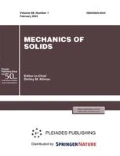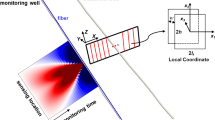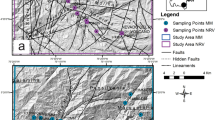Abstract
In this paper, a model is developed for the geomechanical state of coal-rock mass containing the following: the seam and the hydraulic fracture for effectively applying a method of directional hydraulic fracturing of solid rocks. The model is based on the provisions of solid mechanics and Griffiths–Irwin linear fracture mechanics and is implemented using the method of boundary integral equations. Using the model, a large-scale computational experiment was carried out for specific mining and geological conditions of a coal deposit. Based on the analysis of the obtained results, a number of features in the propagation of the crack were identified.

Similar content being viewed by others
REFERENCES
I. M. Petukhov and A. M. Linkov, The Mechanics of Rock Bursts and Discharges (Nedra, Moscow, 1983) [in Russian].
G. L. Fisenko, The State of Rocks around an Excavation (Nedra, Moscow, 1976) [in Russian].
I. A. Turchaninov, M. A. Iofis, and E. V. Kasparyan, Fundamentals of Rock Mechanics (Nedra, Leningrad, 1989) [in Russian].
V. I. Klishin, L. V. Zvorygin, A. V. Lebedev, and A. V. Savchenko, Security Problems and New Technologies of Underground Coal Mining (Novosibirskii pisatel’, Novosibirsk, 2011) [in Russian].
Y. P. Zheltov and S. A. Khristianovich, “On the hydraulic break of a petroliferous layer,” Izv. Akad. Nauk SSSR. Otd. Tekhn. Nauk, No. 6, 3–41 (1955).
S. G. Cherny, V. N. Lapin, D. V. Osipov, and D. S. Kurenkov, Methods for Modeling of Initiation and Propagation of Cracks (Siberian Branch RAS, Novosibirsk, 2016) [in Russian].
V. V. Zubkov, V. F. Koshelev, and A. M. Linkov, “Numerical modelling of hydraulic fracture initiation and development,” J. Min. Sci. 43 (1), 40 (2007).
P. A. Martynyuk, “Features of hydraulic fracture growth in the compression field,” J. Min. Sci. 44 (6), 544–553 (2008).
C. Yan and H. Zheng, “A two-dimensional coupled hydro-mechanical finite-discrete model considering porous media flow simulating hydraulic fracturing,” Int. J. Rock Mech. Min. Sci., No. 88, 137–150 (2016).
E. V. Teodorovich, A. A. Trofimov, and I. D. Shumilin, “Shape of a plane hydraulic fracture crack in an elastic impermeable medium at various injection rates,” Fluid Dyn. 46 (4), 603–612 (2011).
K. Yoshioka and B. Bourdin, “A variational hydraulic fracturing model coupled to a reservoir simulator,” Int. J. Rock Mech. Min. Sci., No. 88, 137–150 (2016).
X. Binwei, Z. Xuan, Y. Bin, and J. Jinlong, “Weakening effects of hydraulic fracture in hard roof under the influence of stress arch,” Int. J. Min. Sci. Techn., No. 28, 951–958 (2018).
V. V. Sokolovsky, Loose Medium Statics (Nauka, Moscow, 1990) [in Russian].
G. N. Kuznetsov, “Limit state of solid rock, given the spatial orientation of the surfaces of easing,” Tr., Vses. Nauchno-Issled. Inst. Molochn. Prom-sti., No. 43, 98–112 (1961).
N. V. Cherdantsev, “The results of numerical solution of the equations of limit state boundary formation areas and their approximation by polynomials,” Labor Saf. Ind., No. 6, 7–13 (2019).
A. I. Lurie, Theory of Elasticity (Nauka, Moscow, 1970) [in Russian].
V. Z. Parton and P. I. Perlin, Methods of Mathematical Theory of Elasticity (Nauka, Moscow, 1981) [in Russian].
N. V. Cherdantsev and S. V. Cherdantsev, “Development of a model of geomechanical state of coal-rock mass, containing mine working,” Labour Saf. Ind., No. 11, 41–45 (2014).
N. V. Cherdantsev and S. V. Cherdantsev, “Analysis of the state for a coal massif in-seam working and a geological discontinuity,” Mech. Solids 53 (2), 211–220 (2018).
L. V. Kantorovich and V. I. Krylov, Approximate Methods of Higher Analysis (Nauka, Moscow, Leningrad, 1962) [in Russian].
Yu. N. Rabotnov, Mechanics of Deformable Solids (Nauka, Moscow, 1988) [in Russian].
N. V. Cherdantsev, “On some conditions of the occurrence of the limit state of the roof of a coal seam when practicing the cleaning developm coy,” Labor Saf. Ind., No. 5, 17–22 (2017).
S. V. Cherdantsev and N. V. Cherdantsev, “Effect of a precompressed spring on the discontinuity zone around a cylindrical cavity,” J. Appl. Mech. Techn. Phys. 46 (3), 423–429 (2005).
N. V. Cherdantsev, V. T. Presler, and V. Yu. Isakson, “Geomechanical state of strength-anisotropic rock mass in the vicinity of mating tunnels,” J. Min. Sci. 46 (2), 143–148 (2010).
L. I. Sedov, Continuum Mechanics (Nauka, Moscow, 1984) [in Russian].
L. M. Kachanov, Fundamentals of Fracture Mechanics (Nauka, Moscow, 1974) [in Russian].
K. Hellan, Introduction to Fracture Mechanics (Univ. Press, Trondheim, 1984).
I. V. Baklashov, Fundamentals of Geomechanics (Sholokhov Moscow State University for Humanities, Moscow, 2004), Vol. 1 [in Russian].
I. N. Sneddon and D. S. Berry, The Classical Theory of Elasticity (Springer-Verlag, Berlin, Heidelberg, 1958).
Y. Murakami, The Society of Materials Science (Pergamon Books, Tokyo, 1987).
N. V. Cherdantsev, “On one variant of calculating the trajectory of a crack loaded with internal pressure in the roof of a formation,” Labour Saf. Ind., No. 12, 5–10 (2017).
N. V. Cherdantsev, “Modelling the trajectory of a fracture that moves under the influence of the fluid pressure in hard rock roofs of in-seam working,” IOP Conf. Ser.: Earth Environ. Sci. 206, 012005 (2018). https://doi.org/10.1088/1755-1315/206/1/012005
Funding
The work was supported by the Russian Science Foundation, project no. 17-17-01143.
Author information
Authors and Affiliations
Corresponding author
Additional information
Translated by A. Ivanov
About this article
Cite this article
Cherdantsev, N.V. Approach to Constructing a Hydraulic Fracture Trajectory in a Rock Mass Near a Mine Working. Mech. Solids 55, 1372–1391 (2020). https://doi.org/10.3103/S0025654420080063
Received:
Revised:
Accepted:
Published:
Issue Date:
DOI: https://doi.org/10.3103/S0025654420080063




